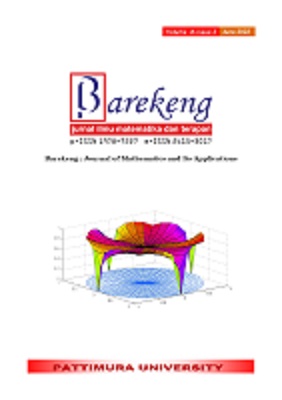FORECASTING OF CURRENCY CIRCULATION IN INDONESIA USING HYBRID EXTREME LEARNING MACHINE
Abstract
Forecasting currency circulation, including inflow and outflow, is one of Bank Indonesia's strategies to maintain the Rupiah value's stability. The characteristic of inflow and outflow data is that they have seasonal variations. This study proposes a hybrid model by combining decomposition techniques and Extreme Learning Machine to overcome data that has seasonal variations. The forecasting results of the proposed model are compared with the original Extreme Learning Machine. The comparison results show that the forecasting results with the hybrid model have the smallest errors. Thus, the hybrid model can predict data with seasonal variations better than the original Extreme Learning Machine.
Downloads
References
Bank Indonesia, “Status and Position of Bank Indonesia.” https://www.bi.go.id/en/tentang-bi/profil/default.aspx (accessed Feb. 09, 2022).
Bank Indonesia, Peraturan Bank Indonesia No 21/10/PBI/2019 Tentang Pengelolaan Uang Rupiah. Indonesia, 2019.
S. Hylleberg, Modelling Seasonality. Oxford: Oxford University Press, 1992.
S. G. Makridakis, S. C. Wheelwright, and R. J. Hyndman, Forecasting: Methods and Applications Third Edition. New York: John Wiley & Sons, Inc., 1997.
D. C. Montgomery, C. L. Jennings, and M. Kulahci, Time Series Analysis and Forecasting Second Edition. Hoboken, New Jersey: John Wiley & Sons, Inc., 2015.
C. E. Holt, Forecasting Seasonals and Trends by Exponentially Weighted Averages (O.N.R. Memorandum No. 52). Pittsburgh USA: Carnegie Institute of Technology, 1957.
P. R. Winters, “Forecasting Sales by Exponentially Weighted Moving Averages,” Manage. Sci., vol. 6, no. 3, pp. 324–342, 1960.
W. M. Persons, “Indices of Business Conditions,” Rev. Econ. Stat., vol. 1, pp. 5–107, 1919.
W. M. Persons, “Correlation of Time Series,” J. Am. Stat. Assoc., vol. 18, no. 142, pp. 713–726, 1923.
G. E. P. Box and G. M. Jenkins, Time Series Analysis: Forecasting and Control. SanFransisco: Holden-Day, Revised edn, 1976.
V. Amaratunga, L. Wickramasinghe, A. Perera, J. Jayasinghe, U. Rathnayake, and J. G. Zhou, “Artificial Neural Network to Estimate the Paddy Yield Prediction Using Climatic Data,” Math. Probl. Eng., vol. 2020, 2020, doi: 10.1155/2020/8627824.
A. K. Mahto, M. A. Alam, R. Biswas, J. Ahmad, and S. I. Alam, “Short-Term Forecasting of Agriculture Commodities in Context of Indian Market for Sustainable Agriculture by Using the Artificial Neural Network,” J. Food Qual., vol. 2021, 2021, doi: 10.1155/2021/9939906.
F. Chen, “Deep Neural Network Model Forecasting for Financial and Economic Market,” J. Math., vol. 2022, 2022.
A. Tealab, H. Hefny, and A. Badr, “Forecasting of Nonlinear Time Series Using ANN,” Futur. Comput. Informatics J., vol. 2, no. 1, pp. 39–47, 2017, doi: 10.1016/j.fcij.2017.05.001.
E. Dobrescu, D. I. Nastac, and E. Pelinescu, “Short-term Financial Forecasting Using ANN Adaptive Predictors in Cascade,” Int. J. Process Manag. Benchmarking, vol. 4, no. 4, pp. 376–405, 2014, doi: 10.1504/IJPMB.2014.065519.
L. Wu, C. Kong, X. Hao, and W. Chen, “A Short-Term Load Forecasting Method Based on GRU-CNN Hybrid Neural Network Model,” Math. Probl. Eng., vol. 2020, 2020, doi: 10.1155/2020/1428104.
X. Jiang, H. Ling, J. Yan, B. Li, and Z. Li, “Forecasting Electrical Energy Consumption of Equipment Maintenance Using Neural Network and Particle Swarm Optimization,” Math. Probl. Eng., vol. 2013, 2013, doi: 10.1155/2013/194730.
P. D. Bobate and V. N. Ghate, “Short-Term Load Forecasting with Artificial Neural Network,” in 2018 3rd IEEE International Conference on Recent Trends in Electronics, Information and Communication Technology, RTEICT 2018 - Proceedings, 2018, pp. 1276–1280, doi: 10.1109/RTEICT42901.2018.9012625.
N. Do Hoai, K. Udo, and A. Mano, “Downscaling Global Weather Forecast Outputs Using ANN for Flood Prediction,” J. Appl. Math., vol. 2011, 2011, doi: 10.1155/2011/246286.
Z. Ali et al., “Forecasting Drought Using Multilayer Perceptron Artificial Neural Network Model,” Adv. Meteorol., vol. 2017, 2017, doi: https://doi.org/10.1155/2017/5681308.
M. P. Darji, V. K. Dabhi, and H. B. Prajapati, “Rainfall Forecasting Using Neural Network : A Survey,” in 2015 International Conference on Advances in Computer Engineering and Applications (ICACEA) IMS Engineering College, Ghaziabad, India, 2015, pp. 706–713.
S. Wang, R. Zhou, and L. Zhao, “Forecasting Beijing Transportation Hub Areas’s Pedestrian Flow Using Modular Neural Network,” Discret. Dyn. Nat. Soc., vol. 2015, 2015, doi: http://dx.doi.org/10.1155/2015/749181.
J. J. Siang, Jaringan Syaraf Tiruan dan Pemogramannya Menggunakan Matlab. Yogyakarta: Penerbit Andi, 2005.
G. B. Huang, Q. Y. Zhu, and C. K. Siew, “Extreme Learning Machine: A New Learning Scheme of Feedforward Neural Networks,” in Proceedings of the Internation Joint Conference on Neural Networks, 2004, pp. 985–990.
R. J. Hyndman and G. Athanasopoulos, Forecasting: Principles and Practice Second Edition. Melbourne: OTexts, 2018.
G. B. Huang, Q. H. Zhu, and C. K. Siew, “Extreme Learning Machine: Theory and Applications,” Neurocomputing, vol. 70, no. 1–3, pp. 489–501, 2006.
J. J. M. Moreno, A. P. Pol, A. S. Abad, and B. C. Blasco, “Using the R-MAPE Index as a Resistant Measure of Forecast Accuracy,” Psicothema, vol. 25, no. 4, pp. 500–506, 2013.
Authors who publish with this Journal agree to the following terms:
- Author retain copyright and grant the journal right of first publication with the work simultaneously licensed under a creative commons attribution license that allow others to share the work within an acknowledgement of the work’s authorship and initial publication of this journal.
- Authors are able to enter into separate, additional contractual arrangement for the non-exclusive distribution of the journal’s published version of the work (e.g. acknowledgement of its initial publication in this journal).
- Authors are permitted and encouraged to post their work online (e.g. in institutional repositories or on their websites) prior to and during the submission process, as it can lead to productive exchanges, as well as earlier and greater citation of published works.






1.gif)



